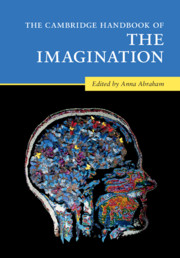Book contents
- The Cambridge Handbook of the Imagination
- The Cambridge Handbook of the Imagination
- Copyright page
- Dedication
- Contents
- Figures
- Contributors
- Acknowledgments
- 1 Surveying the Imagination Landscape
- Part I Theoretical Perspectives on the Imagination
- Part II Imagery-Based Forms of the Imagination
- Part III Intentionality-Based Forms of the Imagination
- Part IV Novel Combinatorial Forms of the Imagination
- 27 On the Interaction Between Episodic and Semantic Representations – Constructing a Unified Account of Imagination
- 28 How Imagination Supports Narrative Experiences for Textual, Audiovisual, and Interactive Narratives
- 29 Development of the Fantasy-Reality Distinction
- 30 Imagining the Real: Buddhist Paths to Wholeness in Tibet
- 31 Hypothetical Thinking
- 32 The Counterfactual Imagination: The Impact of Alternatives to Reality on Morality
- 33 A Look Back at Pioneering Theories of the Creative Brain
- Part V Phenomenology-Based Forms of the Imagination
- Part VI Altered States of the Imagination
- Name Index
- Subject Index
- References
33 - A Look Back at Pioneering Theories of the Creative Brain
from Part IV - Novel Combinatorial Forms of the Imagination
Published online by Cambridge University Press: 26 May 2020
- The Cambridge Handbook of the Imagination
- The Cambridge Handbook of the Imagination
- Copyright page
- Dedication
- Contents
- Figures
- Contributors
- Acknowledgments
- 1 Surveying the Imagination Landscape
- Part I Theoretical Perspectives on the Imagination
- Part II Imagery-Based Forms of the Imagination
- Part III Intentionality-Based Forms of the Imagination
- Part IV Novel Combinatorial Forms of the Imagination
- 27 On the Interaction Between Episodic and Semantic Representations – Constructing a Unified Account of Imagination
- 28 How Imagination Supports Narrative Experiences for Textual, Audiovisual, and Interactive Narratives
- 29 Development of the Fantasy-Reality Distinction
- 30 Imagining the Real: Buddhist Paths to Wholeness in Tibet
- 31 Hypothetical Thinking
- 32 The Counterfactual Imagination: The Impact of Alternatives to Reality on Morality
- 33 A Look Back at Pioneering Theories of the Creative Brain
- Part V Phenomenology-Based Forms of the Imagination
- Part VI Altered States of the Imagination
- Name Index
- Subject Index
- References
Summary
A few brave researchers ventured into the arena of creative cognition, with three in particular – Kenneth Heilman (2003), Arne Dietrich (2004), and Alice Flaherty (2005) – putting forth specific theoretical constructs amenable to empirical research. These theories emerged at the front end of a large body of neuroimaging research regarding brain correlates of creative cognition emerging in the early part of the twenty-first century. Hundreds of studies followed these pioneers’ thoughtful attempts to isolate creative capacity within brain structure and function. Two major questions are addressed: (1) How did their theories hold up in light of empirical data? (2) Do their theoretical constructs have implications for the nascent hypothesizing around imagination ability?
Keywords
- Type
- Chapter
- Information
- The Cambridge Handbook of the Imagination , pp. 548 - 562Publisher: Cambridge University PressPrint publication year: 2020

